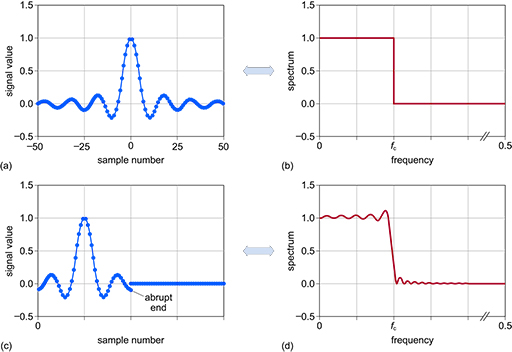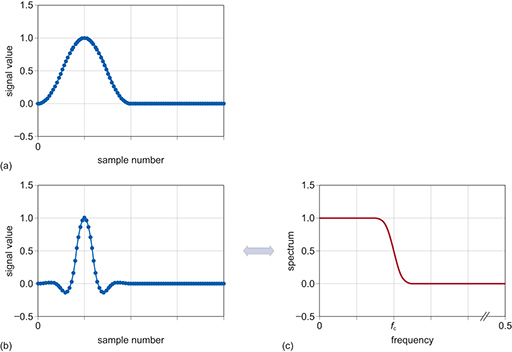3.7 Fourier transforms and the sinc pulse
You saw earlier (Figure 5) that the ideal frequency responses shown in Figure 22 are sometimes referred to as brick-wall filters because of the sharp transitions between passbands and stop bands. In other words, they are rectangular functions. However, whilst it is possible to use a rectangular function in the frequency domain to specify the filter, you must perform the calculations to implement the filter in the time domain. To do this, you need to translate between the time and frequency domains; in particular, for a brick-wall filter, you need to know what a rectangular function in the frequency domain looks like in the time domain. For a continuous-time system, you would use a Fourier transform to do this; for a discrete-time system, you use a corresponding discrete-time Fourier transform.
You can perform mathematical calculations on paper to work out the Fourier transform of a signal in either the time or the frequency domain. Under those circumstances, you would use the formula for either the discrete or the continuous transform, depending on the type of system you were dealing with. However, the majority of Fourier transforms will be carried out by a computer system – even if the system is dealing with continuous-time signals as input and output, the signal processing will be happening in the discrete-time domain of the computer. There is a particular algorithm called the fast Fourier transform (FFT) that is used to carry out Fourier transforms efficiently. Such was the need to perform these calculations at great speed that the FFT was included in a list of the top 10 algorithms of the twentieth century by the IEEE journal Computing in Science & Engineering in the year 2000 (Dongarra and Sullivan, 2000).
Using the discrete-time Fourier transform, you can see that the time-domain representation of a rectangular function in the frequency domain is the sinc pulse, as shown in Figure 24.

Mathematically, a sinc pulse or sinc function is defined as sin(x)/x.
Figure 25(a) and Figure 25(b) show a sinc envelope producing an ideal low-pass frequency response. However, there is an issue because the sinc pulse continues to both positive and negative infinity along the time axis. Whilst mathematically you can readily take the Fourier transform of a sinc pulse, it can’t be computed because of the extension to infinity. The obvious solution is to truncate the sinc response as in Figure 25(c), so that the ripples no longer extend to infinity. Now that the pulse is finite, it can be shifted so that it only has positive sample numbers. The effects of this in the frequency domain are shown in Figure 25(d) – ripples in the passband and the stop band. In essence this shows why you can never have the perfect ideal or ‘brick-wall’ filter.

A technique for dealing with the truncated sinc is to apply a window function that brings the endpoints of the truncated sinc to zero. Figure 26(a) shows a suitable shape of window, Figure 26(b) shows the effects of applying the window to the truncated sinc and Figure 26(c) shows the resultant frequency response.

When a window function is applied, it is effectively ‘multiplied’ with the sinc function. The process used to do this is called convolution. Convolution is outside the scope of this course, but when applied, what is left is where the signals overlap. You can think of this as a ‘view’ through the window function.
There are various shapes of window that can be applied. Two common shapes are the Blackman window and the Hamming window, although there are others (such as Kaiser, Bartlett and Hann). The Hamming window gives a better transition response, but the Blackman window has better stop-band gain and lower passband ripple.
You are now ready to design a digital filter and try it out.
